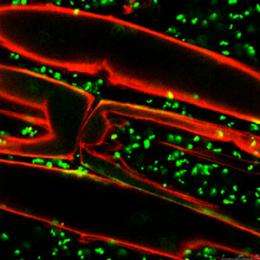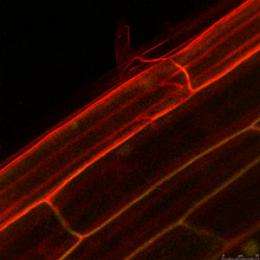The bacterial diseases blackleg and wet rot represent a major challenge to growers of seed potatoes and flower bulbs. They cause substantial economic damage worldwide, including tens of millions of euros in the Netherlands alone. There are no ways to control these pathogens nor are there any resistant varieties. Robert Czajkowski, employed by the Netherlands Institute of Ecology (NIOO) and working at Plant Research International, part of Wageningen UR, has discovered how the organism that causes blackleg and wet rot, the Dickeya bacteria (Erwinia), spreads in the potato plant. He also discovered an antagonistic bacterium that can be used to control the Dickeya bacteria. With his ‘Ecology and control of Dickeya spp. in potato’ research, Czajkowski hopes to obtain his doctorate from Prof. Dr. J.A. van Veen at the Leiden University.
The bacterial diseases blackleg and wet rot are controlled via the inspection of seed potatoes and flower bulbs, and by means of hygienic and production measures that prevent the introduction and spread of these pathogens. More knowledge about the ecology of the pathogenic bacteria could contribute to a better way of controlling these diseases. The results of Czajkowski’s doctorate research into potatoes are also relevant to fighting Dickeya in flower bulb production.
In his research Czajkowski showed how the bacteria can enter the plant roots from the soil within a single day. The bacteria then spread via the vascular system of the plant into its stems, stolons and tubers. If the plant’s aboveground parts are infected, the bacteria can also spread underground via the vascular system and thus infect the tubers. The bacterium is therefore often found in the vascular tissue of the tuber where the stolon is attached to the tuber. Already used when sampling tubers to test seed potatoes, this knowledge can also be deployed to find ways of controlling the bacteria.
Czajkowski found a bacterium (Serratia plymuthica) that effectively controlled the Dickeya bacteria. In greenhouse experiments Dickeya was rarely if ever found on infected tubers in the plant after use of this antagonist. Like Dickeya, the antagonist penetrates the roots and combats the pathogen by producing an antibiotic, among other things. Plant Research International has already patented the antagonist and is studying methods to market it.
Robert Czajkowski has worked for the past 3.5 years on bacterial diseases caused by Dickeya varieties under the guidance of J.M. van der Wolf at Plant Research International. His research was initially financed by Plant Research International, and later from within a project of Technology Foundation STW. The STW financing will continue for another 1.5 years, and be used by Czajkowski to perform field tests, develop better disinfection methods for potato tubers, and research how to increase the resistance of potato plants against Dickeya bacteria.
Provided by Wageningen University























